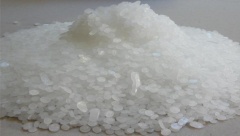Paraffin Wax
| Infobox on Paraffin Wax | |
|---|---|
| Example of Paraffin Wax |  |
| Facts | |
| Origin | - |
| Stowage factor (in m3/t) | - |
| Humidity / moisture | - |
| Ventilation | - |
| Risk factors | See text |
Paraffin Wax
Description
Paraffin wax refers to a white or colourless soft solid that is used as a lubricant and for other applications. It is derived from petroleum and consists of a mixture of hydrocarbon molecules containing between twenty and forty carbon atoms. It is solid at room temperature and begins to melt above approximately 37 °C; its boiling point is >370 deg C. In chemistry, paraffin is used synonymously with "alkane", indicating hydrocarbons with the general formula CnH2n+2. The name is derived from Latin parum ("barely") + affinis, meaning "lacking affinity" or "lacking reactivity" indicating paraffin's unreactive nature.
It is insoluble in water, but soluble in ether, benzene, and certain esters. Paraffin is unaffected by most common chemical reagents but burns readily.
Paraffin wax is an excellent electrical insulator, with an electrical resistivity of between 1013 and 1017 ohm metre. This is better than nearly all other materials except some plastics (notably Teflon). It is an effective neutron moderator.
Paraffin wax is an excellent material to store heat, having a specific heat capacity of 2.14–2.9 J g−1 K−1 (joule per gram kelvin) and a heat of fusion of 200–220 J g−1. This property is exploited in modified drywall for home building material: a certain type (with the right melting point) of wax is infused in the drywall during manufacture so that, when installed, it melts during the day, absorbing heat, and solidifies again at night, releasing the heat. Paraffin wax phase change cooling coupled with retractable radiators was used to cool the electronics of the Lunar Rover. Wax expands considerably when it melts and this allows its use in wax thermostatic element thermostats for industrial, domestic and, particularly, automobile purposes.
The feedstock for paraffin is slack wax. Slack wax is a mixture of oil and wax, a byproduct from the refining of lubricating oil.
The first step in making paraffin wax is to remove the oil (de-oiling or de-waxing) from the slack wax. The oil is separated through crystallization. Most commonly, the slack wax is heated, mixed with one or more solvents such as a ketone and then cooled. As it is cooled, wax crystallizes out leaving oil in solution. This mixture is filtered into two streams: solid (wax plus some solvent) and liquid (oil and solvent). After the solvent is recovered by distillation, the resulting products are called "product wax" (or "press wax") and "foots oil". The lower the percentage of oil in the wax the more refined it is considered (semi-refined versus fully refined). The product wax may be further processed to remove colors and odors. The wax may finally be blended together to give certain desired properties such as melt point and penetration. Paraffin wax is sold in either liquid or solid form.
The feedstock for paraffin is slack wax. Slack wax is a mixture of oil and wax, a byproduct from the refining of lubricating oil.
The first step in making paraffin wax is to remove the oil (de-oiling or de-waxing) from the slack wax. The oil is separated through crystallization. Most commonly, the slack wax is heated, mixed with one or more solvents such as a ketone and then cooled. As it is cooled, wax crystallizes out leaving oil in solution. This mixture is filtered into two streams: solid (wax plus some solvent) and liquid (oil and solvent). After the solvent is recovered by distillation, the resulting products are called "product wax" (or "press wax") and "foots oil". The lower the percentage of oil in the wax the more refined it is considered (semi-refined versus fully refined). The product wax may be further processed to remove colours and odours. The wax may finally be blended together to give certain desired properties such as melt point and penetration. Paraffin wax is sold in either liquid or solid form.
Application
Use: Candles; paper coating; protective sealant for food products, beverages, etc.; glass-cleaning preparations; hot melt carpet backing; bioidegradable mulch (hot melt-coated paper), impregnating matches, lubricants; crayons; surgery; stoppers for acid bottles; electrical insulation; floor polishes; cosmetics; photography; anti-frothing agent in sugar refining; packing tobacco products; protecting rubber products from sun-cracking; chewing gum base.
Shipment / Storage / Risk factors
A white, transparent solid shipped in bags, barrels and cases. The melting point of hard paraffin wax is between 50°C and 60°C and that of soft paraffin wax between 45°C and 50°C. Melting does not affect the value of the commodity. When transported in bags should not be overstowed as this may lead to bonding together of sacks. Maximum height for storage is 5 sacks for soft wax and 9 sacks for hard wax.
Should be stowed away from goods liable to be contaminated by melting wax. Will also take taint from odorous goods.
Heat- sensitive- and fire-dangerous cargo. Surrounding cargo must be protected from tainting. Do not use wire net slings. Paraffin will be shipped in bags or boxes and has to be stowed in a cool place and sun-protected. Do not stow close to odor emitting vapors and do not use dunnage.
The heads of the bags should be stowed towards- and tightly against each other. A smooth surface to be kept. Unrefined paraffin (crude scale wax) must be kept away and separated from refined wax. Cargo has to be well ventilated.
Reference is made to the relevant IMO regulations on hazardous cargo.











